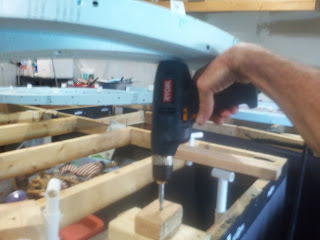Anyway, I placed smokejacks on 12" centers (approximately) under the eastbound tracks down to McGinley. I found I can fasten the roadbed to the supports as I go and adjust them later. I haven't done this yet because I'm still experimenting with the support system. One thing I'm not satisfied with are the "Tee" uprights. Some of the horizontal pipes are not glued properly. Others are not perpendicular to the vertical. I've been trying various ways to get a better fit at that joint. In general, however, the idea seems to work...
 |
| Forest of PVC Supports |
The fact that the roadbed is contiguous is a mixed blessing. For one, you can lift the entire thing out of the way if you need to work under it. Of course, this only works until you start fastening the spline to its supports....
 |
| "you can lift the entire thing out of the way" |
The flip side is that when you move one part of the spline the whole thing moves over a wide area. This creates some weird issues. I think I mentioned several entries ago that changing one curve radius can affect other curves around it. The same thing applies to elevation. If one area drops it tends to lift the adjacent area, pivoting on whatever support happens to be available. I'm still getting used to working with it.
Because of the track arrangement several supports may be required in the same area. Bennigton, especially, requires multiple smokejacks because of the three diverging routes. The "slide" required supports to be at different heights, even though they are directly adjacent...
 |
| The Slide |
 |
| Bennington Viewed From McGinley |
The length of the supports at the upper parts of the hill vary much more than I thought they would. At the Slide, for instance, one support under MP11 on the eastbound tracks is 10" tall. The support for the westbound tracks at the same location is only 8". There are post sockets mounted on "spanners" and others are mounted directly on the benchwork. Locating all these sockets and supports is made much easier by the fact that I marked the "mileposts" on the roadbed ahead of time.
 |
| PVC Spanner |
I have also seen that I can create spanners out the supports themselves when needed. In the photo above I'm experimenting with one at MP2. It supports the eastbound main and the end of the helper loop.
 |
| Wood Spanner |
New problems and solutions with this system are everywhere. I'm learning as I go so progress is pretty slow at this point. The construction methods being used here will certainly evolve into better procedures by the time I reach the bottom of the hill.
Regards,
Frank Musick
Chief Cook and Bottle Washer
 |
| Allegheny Eastern Railroad |

Perhaps you can solve the right angle issue with your uprights by making a jig for cutting the circular cutout. Mount a sanding drum on drill motor at a right angle to a piece of flat stock with a fence. Place the PCV tube against the fence and feed into the rotating drum.
ReplyDelete